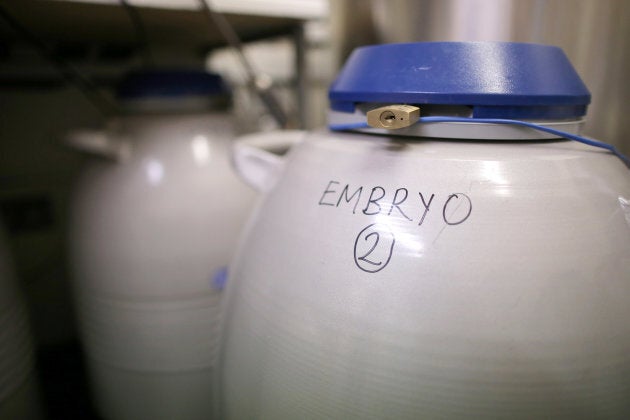
In vitro fertilization (IVF) is a common fertility treatment for couples that cannot conceive naturally. The woman must take hormone injections (gonadotropins) for about 10 days to stimulate the ovaries to produce many eggs. This is carried out under the watchful eye of a fertility doctor who performs frequent ultrasounds to make sure she is not making too many, or too few, eggs. When the follicles (the fluid sacs around the eggs) reach the right size, the eggs are removed from each sac using a thin needle.
Eggs are then taken to a laboratory for fertilization with sperm. If the sperm is not functioning perfectly, an IVF scientist (embryologist) can inject a single sperm directly into the egg. This is called ICSI (intracytoplasmic sperm injection). The resulting embryos are then grown in an incubator for three to five days before being transferred back into the woman's uterus. Extra embryos can be frozen for future use. A pregnancy test as soon as nine days later will determine whether the treatment worked.
As a fertility doctor, I get to talk to a lot of couples about fertility treatment. There are a lot of misconceptions out there! Here are the of the most common regarding IVF:
1. You will end up with triplets
While it's true that the ovaries are stimulated to grow many eggs, these eggs are removed from the body before fertilization. Fertilization then happens in the laboratory, hence the term "test-tube babies." The embryos can later be transferred back into the uterus in a controlled fashion (often one at a time). In 2015, Canadian fertility clinics had only 12 per cent of their IVF pregnancies result in twins and this was almost always the result of putting back more than one embryo. Triplets are very rare with IVF. The type of fertility treatment with the highest risk for triplets is called superovulation. In this treatment, hormone injections grow many eggs but then the eggs ovulate freely into the woman's body. The sperm, which is inseminated into the uterus, will naturally try to fertilize as many eggs as possible. Remember Octomom?

2. Success is guaranteed
Unfortunately, IVF does not guarantee a baby. The average Canadian success rates for IVF in 2015:
- 47 per cent for women under 35
- 42 per cent for women 35-37
- 33 per cent for women 38-40
- 22 per cent for women 41-42 years old
Wondering why we're talking about 2015 stats?
Because of the 40 weeks that it takes to grow a baby, statistics for IVF are often reported a year later when all of the birth data is available. IVF is still a very effective treatment. To put these success rates in perspective, keep in mind that under perfect circumstances, even couples in their 20s have a maximum pregnancy chance of 20-30 per cent per month. Couples that have been trying for more than one to two years without success have a pregnancy rate lower than five per cent per month, depending on the problem.
3. The hormone injections make you crazy
Fertility medications come in two main categories: tablets and injections. Hormone injections for IVF are generally associated with fewer mood side effects than the tablets. That's not to say that gonadotropins are side-effect-free. While the ovaries are growing lots of eggs, a woman can feel bloated and sore. Strenuous exercise is not permitted and neither is intercourse. Patients occasionally do tell me that their high estrogen levels during IVF affect their moods or cause headaches.

Clomiphene citrate and letrozole (Clomid™ and Femara™) are the tablets used for fertility treatment. They are both designed to temporarily reduce the estrogen level in a woman's body and stimulate the release of more of her natural gonadotropins (i.e. the same hormones that come in the injections). Low estrogen levels can lead to feelings of depression, anxiety or irritability. Bloating, nausea and breast soreness can also occur.
4. The needles are huge
Most of the needles for an IVF cycle are small, similar to the type that diabetics use to inject insulin. Usually, we teach couples how to do the injections themselves, at home. The gonadotropin hormones are supposed to be injected just underneath the skin (subcutaneous). Repeated injections can lead to bruising and redness at the injection site but are generally well tolerated. Although the needles are no fun, they usually get easier with practice.
5. Freezing embryos can harm the baby
At the end of an IVF cycle, many couples end up with extra embryos that can be frozen for future use. Modern freezing technology is called vitrification (flash-freezing). The embryos are stored in liquid nitrogen and warmed up when the couple is ready to try again. Freezing does not harm the embryos and they do not get freezer burn. Almost all healthy embryos will survive the freezing-warming process. Research suggests that babies born from frozen embryos do not have a higher rate of birth defects compared to fresh embryos.

Summary
If you're struggling with infertility, the best thing to do is talk to your doctor. A fertility specialist can help you sort through all of the information and get a better understanding of what applies to you. Online resources can be a quick way to get information, but just be cautious about where the information is coming from. IVF is not that mysterious or scary when you learn the facts.
Also on HuffPost: